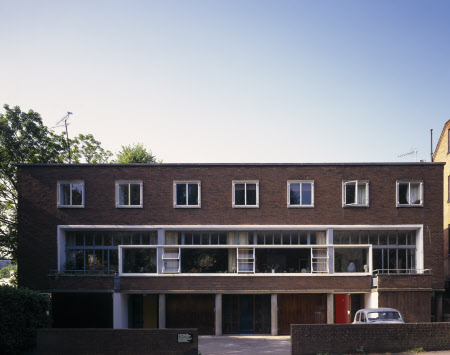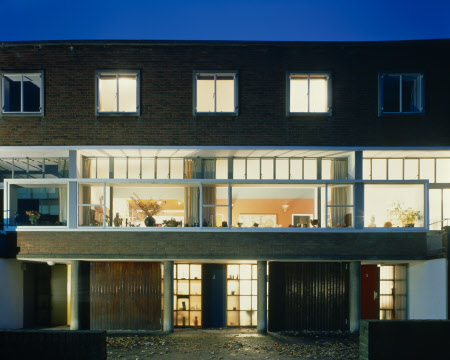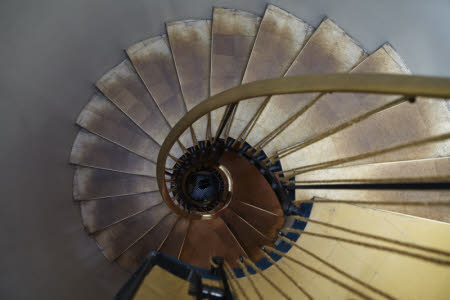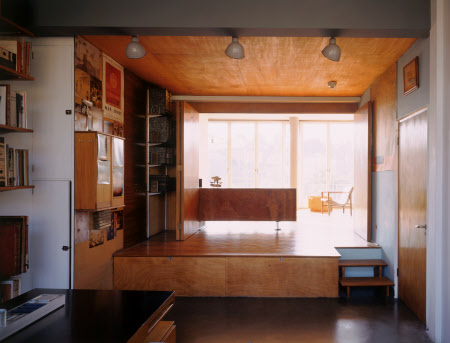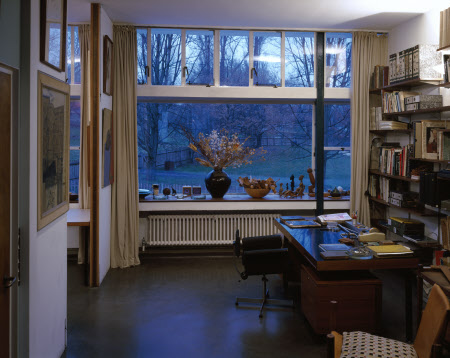Main author
Michael Brooks2 Willow Road
Contents |
[edit] Introduction
2 Willow Road is a terraced house designed by the architect Erno Goldfinger, located in Hampstead, London. It is considered one of the finest examples of modernist housing in the UK.
Goldfinger wanted to build a family home for his own personal use, as well as to test and showcase aspects of modernist design. In 1936, he submitted plans for a block of flats to London County Council, but they were initially rejected. Reducing the scale of his plans, Goldfinger’s final design was submitted in 1937.
However, the plans were strongly opposed by a local residents group, which included the James Bond novelist Ian Fleming and the future Conservative Home Secretary Henry Brooke. Their grievances made the national press.
Goldfinger successfully argued that the housing would conform with the surroundings and the tradition of Georgian building in Hampstead, and would not feature very much exposed concrete. The plans were approved, and the houses were completed in 1939. No.3 was sold off-plan, while No.1 was rented. No.2, the largest was lived in by Goldfinger (and family) until his death in 1987.
[edit] Design and construction
[edit] Exterior
The houses were constructed from concrete and red brick facing, a concession necessitated by the controversy of the plans. In accordance with other modernist houses of the time, it comprised strong, clean lines, with exposed load-bearing concrete columns as part of a reinforced concrete frame, and a stretch of continuous windows across the first floor.
Although the exposed columns and concrete frame would become a characteristic feature of Goldfinger’s style, he did not completely reject the notions of classical architecture in which he had trained. For example, the front elevation includes the use of coping to cast rainwater off and away from the flat roof, thereby avoiding the problems of water staining that afflict other more cube-like modernist buildings.
[edit] Spiral staircase
The external concrete frame provides the structural support for the building, and so the interior is open and spacious, featuring a spiral staircase designed by the engineer Ove Arup. The wedges of concrete stair treads are cantilevered from the surrounding core, avoiding the need for a central column. This allows light from a top floor sky light to flood all the way down.
[edit] Interior
The house is notable for its innovative techniques for maximising the use of space. Movable partitions allow for flexible, open plan living. Often these partitions take the form of folding screens, with one separating his wife’s art studio from the dining room operating on a floor-to-ceiling piano hinge, thereby removing the necessity of a track.
Goldfinger had originally intended for the first floor front window to be entirely made of glass, however, after objection from planners, he designed in a concrete shelf to add more sub-division. Painted white, this served as a light shelf, reflecting natural light deep into the building. On the top floor, the two bathrooms were positioned in the centre of the building, lit using skylights.
Goldfinger did not much like central ceiling lights, so No.2 is lit entirely by wall lights, often with theatre-style glass shades with a brass cup and hinge that he designed himself.
Goldfinger designed most of the furniture for the house, including an innovative desk with horizontally-swiveling drawers, bookshelves, and even the door handles.
[edit] Public tours
2 Willow Road was acquired by the National Trust after Goldfinger’s wife died in 1995. It is now open to the public for guided tours.
The group tours begin with a short introductory film, and are conducted by expert volunteers. As well as holding considerable architectural interest, the house contains Goldfinger’s eclectic collection of 20th century art, with the likes of Bridget Riley, Marcel Duchamp, Henry Moore and Max Ernst.
The National Trust have done a commendable job in maintaining the house, not as a conventional museum, but instead as though Goldfinger had left, with food packets and jars still on kitchen shelves, papers still arranged on the desk, and so on.
For more information and to book a tour, see National Trust.
All images © National Trust Images/Dennis Gilbert.
[edit] Related articles on Designing Buildings Wiki
Featured articles and news
RTPI leader to become new CIOB Chief Executive Officer
Dr Victoria Hills MRTPI, FICE to take over after Caroline Gumble’s departure.
Social and affordable housing, a long term plan for delivery
The “Delivering a Decade of Renewal for Social and Affordable Housing” strategy sets out future path.
A change to adoptive architecture
Effects of global weather warming on architectural detailing, material choice and human interaction.
The proposed publicly owned and backed subsidiary of Homes England, to facilitate new homes.
How big is the problem and what can we do to mitigate the effects?
Overheating guidance and tools for building designers
A number of cool guides to help with the heat.
The UK's Modern Industrial Strategy: A 10 year plan
Previous consultation criticism, current key elements and general support with some persisting reservations.
Building Safety Regulator reforms
New roles, new staff and a new fast track service pave the way for a single construction regulator.
Architectural Technologist CPDs and Communications
CIAT CPD… and how you can do it!
Cooling centres and cool spaces
Managing extreme heat in cities by directing the public to places for heat stress relief and water sources.
Winter gardens: A brief history and warm variations
Extending the season with glass in different forms and terms.
Restoring Great Yarmouth's Winter Gardens
Transforming one of the least sustainable constructions imaginable.
Construction Skills Mission Board launch sector drive
Newly formed government and industry collaboration set strategy for recruiting an additional 100,000 construction workers a year.
New Architects Code comes into effect in September 2025
ARB Architects Code of Conduct and Practice available with ongoing consultation regarding guidance.
Welsh Skills Body (Medr) launches ambitious plan
The new skills body brings together funding and regulation of tertiary education and research for the devolved nation.
Paul Gandy FCIOB announced as next CIOB President
Former Tilbury Douglas CEO takes helm.
UK Infrastructure: A 10 Year Strategy. In brief with reactions
With the National Infrastructure and Service Transformation Authority (NISTA).







